Food Allergies

Symptoms usually start as soon as a few minutes after eating a food and as long as two hours after. In some cases, after the first symptoms go away, a second wave of symptoms comes back one to four hours later (or sometimes even longer). This second wave is called a biphasic reaction.
Food allergies happen when the immune system – the body's defense against infection – mistakenly treats proteins found in food as a threat. As a result, a number of chemicals are released. It's these chemicals that cause the symptoms of an allergic reaction.
- Tingling or itching in the mouth.
- Hives, itching or eczema.
- Swelling of the lips, face, tongue and throat or other parts of the body.
- Wheezing, nasal congestion or trouble breathing.
- Abdominal pain, diarrhea, nausea or vomiting.
- Dizziness, lightheadedness or fainting.
- Milk (mostly in children)
- Eggs.
- Peanuts.
- Tree nuts, like walnuts, almonds, pine nuts, brazil nuts, and pecans.
- Soy.
- Wheat.
- Fish (mostly in adults)
- Shellfish (mostly in adults)
Comments
https://github.com/harelba/q/issues/343
https://github.com/harelba/q/issues/342
https://github.com/Usani2541/ASS4_SEC1_603021736-0/issues/1
https://github.com/ethereumbook/ethereumbook/issues/1231
https://github.com/eatnumber1/goal/issues/217
https://github.com/aixed/WeChat-Hook/issues/110
https://github.com/wizardforcel/eloquent-js-3e-zh/issues/22
https://community.wongcw.com/posts/1086597
https://community.wongcw.com/posts/1086598
https://raindrop.io/Phungam168/prasertpattan168-56276570
https://raindrop.io/Phungam168/patamadec65-56276574
https://yodayo.com/posts/ee9ff349-d5c4-4f54-b090-daf798453c3c
https://mastodon.social/@Bunnisa168/114652312201395807
https://mastodon.social/@Bunnisa168/114652313364949489
https://bsky.app/profile/bunnisa168.bsky.social/post/3lr5vklhynk2i
https://bsky.app/profile/bunnisa168.bsky.social/post/3lr5vkat6fk2i
https://multy.me/4Htfj
https://www.TwosApp.com/684693af65f852e4490a9802
https://www.datascienceportfol.io/truezardhikma/projects/0
https://forum.lexulous.com/user/tanisorn168
https://pastelink.net/5wqig5mr
https://snippet.host/ktskia
https://hoo.be/preeyapat168
https://patcharapdiamond168.graphy.com/courses/DHSeo168Diamond
https://diamond777.graphy.com/courses/BaDiamond168zaThailandNo1MKT
https://diamondfoodballno1.graphy.com/courses/RonaldoMessiDiamond168
https://gizmodouoldmcom.graphy.com/courses/diamondseoba001-682d5839d6e1a7472ca9db31
https://diamondfoodballno1.graphy.com/courses/MessiDiamond168
https://t.co/YKbOJ6nojM
https://t.co/OBbM3LnuBc
https://t.co/7FFtYLjgM3
https://t.co/mKbCmVCy5d
https://t.co/xJ2H3pvKo5
https://raindrop.io/bluerocker-non/dzzz555-55571022
https://x.com/NP5230322012050/status/1925779638673879221
https://cliqueaqui.bio/quef3
https://multy.me/Sou7n
https://abrir.link/IBQwn
https://www.TwosApp.com/6830212ea53a42318b4c1fe8
https://flipboard.com/@np4tch5/bamrungkan1688-7gn72glsz
https://suvanabhumi168.graphy.com/courses/Ruayy44Diamond168
https://tanakiatk168pg.graphy.com/courses/DiamondPGGAme44789
https://watsonkelly6784.graphy.com/courses/HiloonlineThaiDiamond
https://diamond777.graphy.com/courses/DiamondSeoNo1Ba
https://t.co/KEVdQ85W6f
https://t.co/6LOmI6TsMD
https://t.co/KektBygR6q
https://t.co/7kgj5ybLko
https://t.co/DfO6way7Db
https://raindrop.io/bluerocker-non/666z222-55570973
https://x.com/NP5230322012050/status/1925777363356307896
https://cliqueaqui.bio/kfg6p
https://multy.me/gXjhD
https://abrir.link/JxkBC
https://www.TwosApp.com/683020f4a53a42318b4c1f9c
https://flipboard.com/@np4tch5/nitithamr1678-56o5mrhkz
https://github.com/Gongkasemsab2222222/Ratanapirom/issues/1
https://github.com/ChaipodPrasanwong1111/Arthitayapornchai-/issues/1
https://github.com/Gongkasemsab1111111111111/Thanasunthornwong/issues/1
https://github.com/Siripraphachai/Arthitayapornchai-/issues/1
https://github.com/Gongkasemsab111111111/Sukprasert/issues/1
https://github.com/Gongkasemsab33333333/Saisamang/issues/1
https://github.com/Kanjanamas111111111155555/Pongpattana/issues/1
https://github.com/Gongkasemsab111111/Kajornkiatsakul-/issues/1
https://github.com/Gongkasemsab111111122/Prachayasittikul/issues/1
https://github.com/kaina12345678999/kaina123/issues/1
https://github.com/kaina134556666666666/kaina123/issues/1
https://github.com/Bluerocker012311/kaina123/issues/1
https://github.com/Bluerocker0123/kaina123/issues/1
https://github.com/Bluerocker012344/kaina123/issues/2
https://github.com/MacDIAMOND1688/Xaiya/issues/1
https://github.com/MacDIAMOND168/Mack/issues/1
https://github.com/MacDIAMOND168/max/issues/1
https://github.com/DAMDAMme11225566/Natoo/issues/1
https://github.com/MacDIAMOND169/Magoo/issues/1
https://github.com/MacDIAMOND169/muay/issues/1
https://github.com/MacDIAMOND1688/May/issues/1
https://github.com/MacDIAMOND1689/Mac169/issues/1
https://github.com/MacDIAMOND1689/Mac168/issues/1
https://github.com/MacDIAMOND789/DIAMOND/issues/1
https://github.com/MAVKMAVK11111111111142/Mack1259/issues/1
https://github.com/sggsdfsdfdsfds6745123/NAgoo168/issues/1
http://fullservicelavoro.com/ شركة ريلاكس لنقل العفش والاثاث
http://fullservicelavoro.com/2019/01/07/transfer-movers-taif-furniture/ شركة نقل عفش بالطائف
http://fullservicelavoro.com/2019/01/08/transfer-movers-riyadh-furniture/ شركة نقل عفش بالرياض
http://fullservicelavoro.com/2019/01/08/transfer-movers-jeddah-furniture/ شركة نقل عفش بجدة
http://fullservicelavoro.com/2019/01/01/transfer-and-movers-furniture-mecca/ شركة نقل عفش بمكة
http://fullservicelavoro.com/2019/01/07/transfer-movers-madina-furniture/ شركة نقل عفش بالمدينة المنورة
http://fullservicelavoro.com/2019/01/07/transfer-movers-khamis-mushait-furniture/ شركة نقل عفش بخميس مشيط
http://fullservicelavoro.com/2019/01/09/transfer-movers-abha-furniture/ شركة نقل اثاث بابها
http://fullservicelavoro.com/2019/01/07/transfer-movers-najran-furniture/ شركة نقل عفش بنجران
http://fullservicelavoro.com/2019/01/16/transfer-movers-hail-furniture/ ِشركة نقل عفش بحائل
http://fullservicelavoro.com/2019/01/16/transfer-movers-qassim-furniture/ شركة نقل عفش بالقصيم
http://fullservicelavoro.com/2019/02/02/transfer-movers-furniture-in-bahaa/ شركة نقل عفش بالباحة
http://fullservicelavoro.com/2019/01/13/transfer-movers-yanbu-furniture/ شركة نقل عفش بينبع
http://fullservicelavoro.com/2019/01/18/%d8%af%d9%8a%d9%86%d8%a7-%d9%86%d9%82%d9%84-%d8%b9%d9%81%d8%b4-%d8%a8%d8%a7%d8%a8%d9%87%d8%a7/ دينا نقل عفش بابها
http://fullservicelavoro.com/2019/01/13/%D9%86%D9%82%D9%84-%D8%A7%D9%84%D8%A7%D8%AB%D8%A7%D8%AB-%D8%A8%D8%A7%D9%84%D9%85%D8%AF%D9%8A%D9%86%D8%A9-%D8%A7%D9%84%D9%85%D9%86%D9%88%D8%B1%D8%A9-%D8%A7%D9%87%D9%85-%D8%B4%D8%B1%D9%83%D8%A7%D8%AA/ نقل الاثاث بالمدينة المنورة
http://fullservicelavoro.com/2019/01/12/%D8%A7%D8%B1%D8%AE%D8%B5-%D8%B4%D8%B1%D9%83%D8%A9-%D9%86%D9%82%D9%84-%D8%B9%D9%81%D8%B4-%D8%A8%D9%85%D9%83%D8%A9/ ارخص شركة نقل عفش بمكة
http://fullservicelavoro.com/2019/01/07/transfer-movers-elkharj-furniture/ شركة نقل عفش بالخرج
http://fullservicelavoro.com/2019/01/07/transfer-movers-baqaa-furniture/ شركة نقل عفش بالبقعاء
http://fullservicelavoro.com/2019/02/05/transfer-furniture-in-jazan/ شركة نقل عفش بجازان
https://sites.google.com/view/movers-riyadh/
https://sites.google.com/view/movers-riyadh/movers-mecca
https://sites.google.com/view/movers-riyadh/home
https://sites.google.com/view/movers-riyadh/movers-jedaah-elhamdniah
https://sites.google.com/view/movers-riyadh/movers-yanbu
https://sites.google.com/view/movers-riyadh/movers-najran
https://sites.google.com/view/movers-riyadh/movers-Jizan
https://sites.google.com/view/movers-riyadh/jazan
https://sites.google.com/view/movers-riyadh/taif
https://sites.google.com/view/movers-riyadh/moversjeddah
https://sites.google.com/view/movers-riyadh/movers-abha
https://sites.google.com/view/movers-riyadh/movers-elahsa
https://sites.google.com/view/movers-riyadh/movers-elkhobar
https://sites.google.com/view/movers-riyadh/movers-elkharj
https://sites.google.com/view/movers-riyadh/movers-elmadina-elmnowara
https://sites.google.com/view/movers-riyadh/movers-eljubail
https://sites.google.com/view/movers-riyadh/movers-elqassim
https://sites.google.com/view/movers-riyadh/movers-hafrelbatin
https://sites.google.com/view/movers-riyadh/movers-elbaha
https://sites.google.com/view/movers-riyadh/movers-jeddah
https://sites.google.com/view/movers-riyadh/movers-dammam
https://sites.google.com/view/movers-riyadh/movers-taif
https://sites.google.com/view/movers-riyadh/movers-burydah
https://sites.google.com/view/movers-riyadh/movers-tabuk
https://sites.google.com/view/movers-riyadh/movers-hail
https://sites.google.com/view/movers-riyadh/movers-khamis-mushait
https://sites.google.com/view/movers-riyadh/movers-rabigh
https://sites.google.com/view/movers-riyadh/madina
https://sites.google.com/view/movers-riyadh/mecca
https://sites.google.com/view/movers-riyadh/dammam
https://sites.google.com/view/movers-riyadh/jeddah
https://sites.google.com/view/movers-riyadh/ahsa
https://sites.google.com/view/movers-riyadh/cleaning-mecca
https://fullservicelavoro.jimdosite.com/
http://treeads.nation2.com/
https://jumperads.yolasite.com/
http://jumperads.nation2.com/
http://transferefurniture.hatenablog.com
https://atar-almadinah.weebly.com/
https://allmoversinriyadh.wordpress.com/
https://allmoversinriyadh.wordpress.com/2022/04/09/%d8%b4%d8%b1%d9%83%d8%a9-%d8%aa%d9%86%d8%b8%d9%8a%d9%81-%d8%a8%d8%a7%d9%84%d8%b1%d9%8a%d8%a7%d8%b6-%d9%85%d8%ac%d8%b1%d8%a8%d8%a9/
https://allmoversinriyadh.wordpress.com/2022/04/07/%d8%a7%d9%81%d8%b6%d9%84-%d8%b4%d8%b1%d9%83%d8%a9-%d8%aa%d9%86%d8%b8%d9%8a%d9%81-%d8%a8%d8%a7%d9%84%d8%b1%d9%8a%d8%a7%d8%b6/
https://allmoversinriyadh.wordpress.com/2022/05/13/%d8%b4%d8%b1%d9%83%d8%a9-%d9%86%d9%82%d9%84-%d8%b9%d9%81%d8%b4-%d9%88%d8%ba%d8%b1%d9%81-%d8%a7%d9%84%d9%86%d9%88%d9%85-%d8%a8%d8%a7%d9%84%d8%b1%d9%8a%d8%a7%d8%b6/
https://companymoversinjeddah.wordpress.com/
https://moversfurniture2018.wordpress.com/2018/12/30/%D8%A7%D9%87%D9%85-%D9%85%D9%83%D8%A7%D8%AA%D8%A8-%D9%88%D9%85%D8%A4%D8%B3%D8%B3%D8%A7%D8%AA-%D8%B4%D8%B1%D9%83%D8%A7%D8%AA-%D9%86%D9%82%D9%84-%D8%B9%D9%81%D8%B4-%D8%A8%D8%AC%D8%A7%D8%B2%D8%A7%D9%86/
https://moversriyadhcom.wordpress.com/
https://moversmedina.wordpress.com/
https://moversfurniture2018.wordpress.com/
https://moversmecca.wordpress.com/
https://khairyayman74.wordpress.com/
https://companymoversmecca.home.blog/
https://companymoverstaif.home.blog/
https://companymoverskhamismushit.home.blog/
https://whitear.home.blog/
https://companyhouseservice.wordpress.com/
http://bestmoversfurniture.wordpress.com/
https://companymoversjeddah.wordpress.com/
https://companycleaning307819260.wordpress.com/
https://companymoversriydah.wordpress.com/
https://ataralmadinah662300791.wordpress.com/
https://groups.google.com/g/moversfurniture/c/wwQFSNvgyAI
https://groups.google.com/g/moversfurniture/c/4L1oHETS4mQ
https://nowewyrazy.uw.edu.pl/profil/khairyayman
https://companyhouseservice.wordpress.com/2022/08/06/%d8%a7%d9%81%d8%b6%d9%84-%d8%b4%d8%b1%d9%83%d8%a9-%d8%aa%d9%86%d8%b8%d9%8a%d9%81-%d8%a8%d8%a7%d9%84%d8%b1%d9%8a%d8%a7%d8%b6/
https://companymovers9.wordpress.com/
https://newmoverdotblog.wordpress.com/
https://qwasdew.wordpress.com/
https://gigisaad.wordpress.com/
